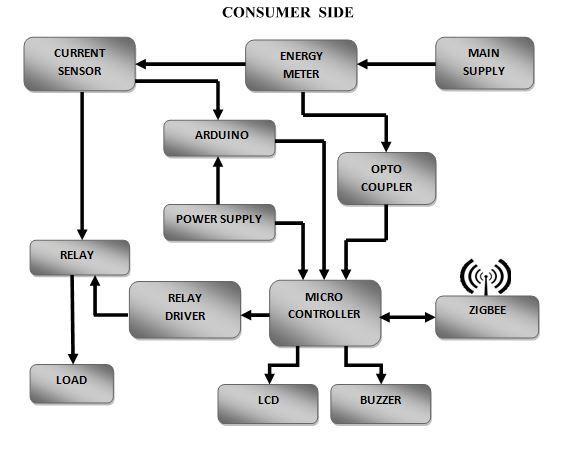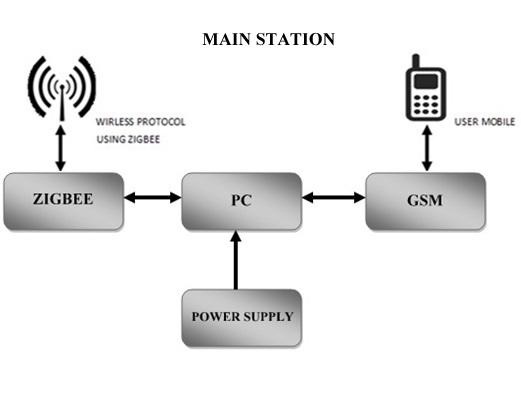





Published on Nov 30, 2023
In this project, the idea of Prepaid Energy using microcontroller and Zigbee protocol has been introduced. This concept provides a cost efficient manner of electricity billing. The present meter billing systems are discrete, inaccurate, costly and slow. They are also time and labor consuming. The major drawback of traditional billing system is inaccurate payment by the customer. This drawback is reduced by using a prepaid meter which is based on the concept "Pay first and then use". Prepaid meter billing systems also reduce the errors made by humans while taking readings to a large extent. The reading from the Energy meters is passed to a microcontroller. The data is suitably processed and sent to a PC, at the Main Station, using Zigbee communication. The recharge is done by issuing prepaid coupon to the customers. Every coupon has a Unique Recharge Number.
The Customer has to send the message with the unique no (recharge R##X) to the main station. At the Main Station, on receiving the message, the account of that particular customer will be credited with the Amount.
Each customer’s usage on electricity will be continuously monitored through the data received from the Zigbee, and according to the power consumed, the amount will be deducted from the customer’s account, and the customers will be updated regarding the usage details, by sending SMS like low balance please recharge, zero balance please recharge, or load temporarily switched OFF due to over load using a GSM Module. A Buzzer is used as an alarm to indicate the users when the recharge amount reaches a Zero and during over load. At the consumer section Relay is used to cut off the supply from the loads on reaching a Zero Balance and also when there is an overload.
Power utilities in India have been striving hard to extend best possible support to customers by improving revenue collection efficiency. Meter reading, preparation of bills its distribution and collection of payments takes away a considerable amount of time and efforts for the utility which can be eliminated by the prepayment metering system. Interestingly electricity supply is one of the only commodity at present which is billed after it is consumed, everything else we use in life (cooking gas, prepay mobiles, grocery, clothes etc.) is paid for before it's used. Demand side management, improved quality of supply along with high customer satisfaction has resulted in acceptance of the new system by utilities everywhere.
Prepayment or pay as you go system is receiving more and more attention worldwide as utilities are looking at ways to improve customer service, improve their cash flow and minimize their risks. The concept of prepaid remains the same but there is going to be a paradigm shift in the application. It's altogether a new arena in Metering India which is likely to be important to revenue and energy management. This will in the days to come, open up new vistas for investment and deployment of infrastructure for better customer services. There will be immense benefits, which will be reaped by the State Electricity Boards (SEBs), private utilites and citizens of India. The objective of the paper is to share the details of Prepayment Metering system as a concept and highlight the role to be played by all stakeholders in getting the concept effectively implemented for the overall benefit of the Indian Power Sector
To Design and develop Intelligent Prepaid System for utilities. Enables the supplier to provide effective services and customer with efficient management of their resources.
This system helps in DIGITATION of entire process of distribution, revenue collection, excess and unauthorized consumption of services.
In RURAL areas this system has additional benefit of reducing the power losses and enables integrated power generation, distribution, revenue collection all in rural areas. This will also enable lot of entrepreneurship to be developed in rural areas.
To minimize the human prone errors by introducing a new system of “PREPAID ENERGYMETERING USING ZIGBEE”.
To reduce the losses occurring due to unpaid and overdue bills by the users.
Benefits both consumers and utilities as it helps Users consume resources more efficiently and improve their management of budget, on the other hand they reduce financial costs and losses to the firm.
Altogether to design a system that eliminates the billing delay, removes cost involved in disconnection/reconnection, enables controlled use of energy, and help customers to save money through better energy management.
The proposed system introduces a new method of meter reading electronically and transmitting to headquarters for further processing. This helps in reducing the manual errors that occur in the present meter reading systems.
Meter reading system can be used to take readings for different utilities such as Electricity, Water, Gasoline (LPG ,CNG) etc.,
Let us consider an example of Electricity; here we are connecting the Energy Meter between main supply and load, by which Microcontroller will be able to measure the energy units consumed by the consumer.
The Microcontroller computes the amount of energy consumed. Then the calculated values are transmitted instantaneously via ZIGBEE to the MAIN STATION and the necessary updates are performed in the DATA BASE of the consumer.
Consumer can recharge his account by using PREPAID COUPONS/ELECTRONICALLY VIA smart phone or by net banking.
Since this is a Prepaid System, based on the amount of recharge made by the customer and the available balance present in customer’s account, PC will compute the net amount, with which consumer would be able to utilize energy supply further.
The consumers will get a message, which has information regarding the balance available and amount of energy consumed through a GSM module. The same data is sent to the microcontroller via ZIGBEE, which will be displayed on the LCD display.
The MAIN STATION monitors the power consumption of the consumers periodically, if the balance amount reaches below the prescribed Minimum value, an SMS will be sent to the Mobile number, which has been registered by the consumers via GSM indicating low balance.
If the balance reaches Zero, a signal will be sent to microcontroller to cut off the supply and n SMS to the consumers indicating this cut off. At the consumer section a breaking circuit is implemented to cut off the supply between main and load.
If there is an overload i.e., whenever the consumers try to access excess supply beyond the limits, Microcontroller will cut off the main supply to the load using Relay. And an SMS will be sent to the registered customer Mobile number indicating Overload.


In the present work Wireless Meter reading system is designed to continuously manage and monitor the Meter reading and helps them to conserve Energy. The design of Smart Meter using GSM technology facilitate the users to pay for the Electricity bill before consumption and an arrangement is also made to notify the users regarding their usage details and also when the balance goes low in their account with the help of GSM Modem. This system has been proposed as an innovative solution to the problem faced in utilities system. Since a microcontroller based system is being designed, the readings can be continuously recorded and maintained in the database. The advantages of Prepaid Energy Meter are it reduces human labor, there is no need to chase for payments, and at the same time increase the efficiency in calculation of bills for used electricity. Prepaid energy meter is more reliable and user friendly.
This system can also be implemented for water, gasoline etc.,
This system also enables utilization of internet of things.
Recharge can be done by online payment.
Tampering of meter can be detected and appropriate message can be sent to the supplier.
The convenience of payment for electricity in terms of location and denominations of one's own choice helps the customer. Prepay mobile industry has increased the level of customer expectation for recharging their mobile phones. A mobile phone can be recharged by buying cash cards from multiple outlets which are conveniently located. Similarly customers for prepayment metering system would look forward for buying electricity conveniently from number of vending outlets. With the technological advancement they would even prefer to purchase electricity using internet, mobile phones and as such an online system just like the banking system would be preferred. Utility would on the other hand like to have negligible initial investment on the vending infrastructure and may in turn agree to pay a per transaction fee.
The successful payment system implementation by the utility, as well as the social ac ceptance among customers coupled with the Regulators support will prove to be a win-win situation for all the stakeholders. The payment system brin gs potential advanta ges with it, but there are certain issues which have to be addressed when moving from a conventional post paid system to a prepayment system so that its introduction on a lar ge scale proves to be beneficial to all the concerned.
[1] Omijeh Bourdillon .O (2012): “A Ph.D thesis on Design andEvaluation of GSM-based Intelligent Prepaid Energy MeteringSystem for Nigeria (GIPEMS) “, Ambrose Alli Universty ,Ekpoma
[2] Shwehdi.M.H and Jackson.C (1996). A microprocessor baseddigital wattmeter system design. proceedings of the 31stIntersociety Conference on Energy Conversion Engineering31:1840-1845.
[3] Zhang.J, Oghanna and Bai.C.L (1998). DSP based electricitymeter with remote reading. proceedings of the 4th InternationalConference on Signal Processing 2 :1581-1584
[4] Koay .B.S, Cheah.S.S, Sng .Y.H,Chong. P.H.J,Shun.P,Tong.Y.C (2003) .Design and implementation of a Bluetooth energy meter. proceedings of the Joint 4th InternationalConference on Information, Communication and Signal.